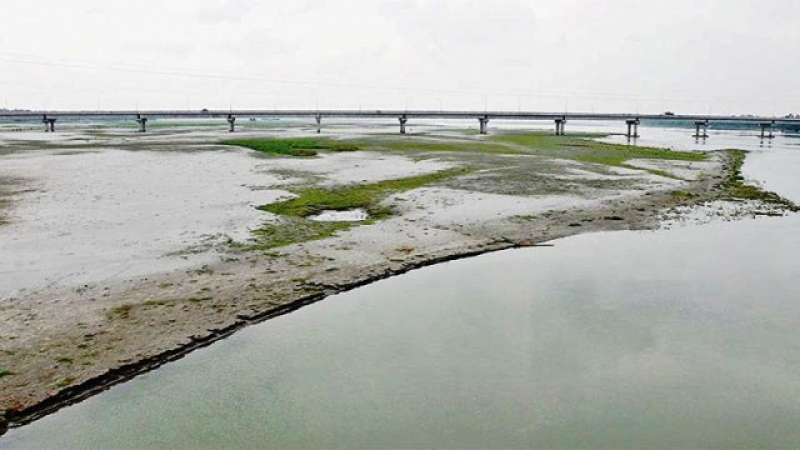- Chief Adviser Dr Yunus pays homage to martyred intellectuals |
- Martyred Intellectuals Day: A Nation’s Loss and Resolve |
- EC seeks enhanced security for CEC, ECs, election officials |
- Humanoid robots take center stage at Silicon Valley summit, but skepticism remains |
- ‘Unhealthy’ air quality was recorded in Dhaka on Sunday |
As Krishna basin faces drought, water diverted from basin to Konkan

Teesta River in Bangladesh goes dry every lean season for diversion of its water in India.
Featured SANDRP
Large parts of South India, including Maharashtra are facing depleted reservoir levels with the beginning of summer and water scarcity. However, the Krishna Bheema basin, the second largest basin of peninsular India, is diverting water to outside the basin to Konkan. The Krishna Bheema basin has the largest live storages of Maharashtra in Koyna dam (1347.5 MCM) and Tata dams (617.67 MCM), but the water in those storages won’t be available to the drought hit residents of Krishna basin in water scarce Maharashtra, Karnataka, Telangana and Andhra Pradesh.
This is because Koyna and Tata dams divert the water from Krishna Bheema basins to Konkan for power generation. Even in March, according to Maharashtra Load Dispatch Centre, Koyna had generated 128.87 Million Units (MU) of power and Tata Dams had generated 130.47 MU, both by March 30. This implies diversion of millions of Cubic meters of water from Koyna and Tata Dams during March 2024, which mostly gone down from Konkan to Arabian sea.
This means even as downstream Ujani dam in Maharashtra has no water in live storage, the water stored in Tata dams won’t be available for Ujani dam dependent people of Bhima basin in Maharashtra. There is need to stop this diversion of water from drought prone Krishna basin in drought years.
We have raised this issue multiple times in the past (e.g. see: https://sandrp.in/2015/08/07/as-krishna-bhima-basin-farmers-in-maharashtra-karnataka-ap-telangana-face-drought-crop-failure-water-scarcity-maharashtra-diverted-350-mcm-water-from-the-basin-literally-to-sea/). We hope the government will wake up to this cruel tragedy that the people of Krishna Bheema basin are facing severe water scarcity, but the water of their basin is being diverted to high rainfall region of Konkan, to basically flow down to Arabian Sea.
HYDRO POWER PROJECTS
What’s wrong with India’s hydropower push? Article by SANDRP coordinator about hydropower and pump storage projects in India. https://psuwatch.com/opinion/damn-it-whats-wrong-with-indias-hydropower-push (27 March 2024) -An opinion piece, ‘Dam(n) it, what’s wrong with India’s hydropower push?’, has raised a number of very serious concerns to our people from the large number of hydel power projects being planned and built in the country. Whereas, the issues have been raised many times in the recent past, civil society has not been able to persuade the concerned authorities, especially the Ministry of Power, Ministry of Environment, NITI Aayog, and PMO, to provide satisfactory clarification to any of these concerns (Shankar Sharma). https://www.counterview.net/2024/04/why-its-time-to-question-very-need-for.html (01 April 2024)
People for Himalaya Demand Charter Environmentalists Propose Alternative Development Model An alternate model of development that recognizes the knowledge and needs of local communities is among the many demands raised by the People for Himalaya Campaign in their charter aimed at party candidates ahead of the Lok Sabha elections. Based on this vision statement, the People for Himalaya Campaign have now released a ‘demand charter’ or maangpatr, said Manshi Asher, founder of Himdhara Collective who is also associated with the Campaign, at an online press conference.
The main intent of the demand charter is to move towards a Himalaya that is secure from disasters, and how we can achieve this, she added. “The entire Himalayan region is going through extreme distress right now,” she said. “These are manifesting in several forms, whether they are slow onset disasters such as the retreat of glaciers due to global warming…to immediate disasters that wreak a lot of havoc that we see on television, whether they are floods or landslides.” https://thewire.in/environment/people-for-himalaya-campaign-calls-for-alternative-devlopment-model-to-free-region-of-disasters (30 March 2024)
The demand for a complete halt on mega infrastructures like large dams, railway and four lane given the underground invasion and muck generation was also echoed by Guman Singh, from Himalaya Niti Abhiyan and Atul Sati of Joshimath Bachao Sangharsh Samiti. It was stated be it the Beas floods or the land subsidence in Joshimath, these are all not natural disasters but man-made, policy led disasters. The over-all demand for a people not profit centred economic and governance was reiterated. https://timesofindia.indiatimes.com/india/himalayan-solidarity-to-secure-future-of-mountains-not-profit-but-people-and-nature-centred-governance-is-way-forward/articleshow/108903282.cms (30 March 2024)
–Among its demands, the People for Himalaya coalition has sought democratic decision-making through referendums and public consultation on large infrastructure by strengthening the Environment Impact Assessment (EIA) Notification 1994, scrapping of the EIA 2020 Amendments & Forest Conservation Amendment Act 2023; free prior informed consent of gram sabhas to be mandatory for all developmental projects; and a just implementation of 2013 Right to Fair Compensation and Rehabilitation Act. – South Asia Netwrok on Dams, Rivers and people (SANDRP).

